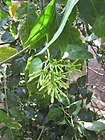Note: This is a project under development. The articles on this wiki are just being initiated and broadly incomplete. You can Help creating new pages.
Difference between revisions of "Cestrum nocturnum - Raat ki rani"
| Line 1: | Line 1: | ||
| − | |||
| − | |||
[[File:(Nyctanthes arbor-tristis) flower at Madhurawada 01.JPG|thumb|right|''Parijata'']] | [[File:(Nyctanthes arbor-tristis) flower at Madhurawada 01.JPG|thumb|right|''Parijata'']] | ||
Revision as of 13:40, 7 June 2018
Cestrum nocturnum is an evergreen shrub growing up to 3.5 metres tall.The plant is widely cultivated in the tropics and subtropics, mainly as an ornamental and hedge plan.
Contents
- 1 Uses
- 2 Parts Used
- 3 Chemical Composition
- 4 Common names
- 5 Habit
- 6 Properties
- 7 Identification
- 8 List of Ayurvedic medicine in which the herb is used
- 9 Where to get the saplings
- 10 Mode of Propagation
- 11 How to plant/cultivate
- 12 Commonly seen growing in areas
- 13 Photo Gallery
- 14 References
- 15 External Links
Uses
tumour growth, Cuts, Snakebites, Curing liver disorders, Skin eruptions, Blotches, Pimples, Diarrhea, Sore throats
Parts Used
Chemical Composition
n-Hexane extract, Soxhlet, MeOH (101), Evaporated under reduced pressure.Methanol extract[1]
Common names
| Language | Common name |
|---|---|
| Kannada | |
| Hindi | Rat ki rani |
| Malayalam | |
| Tamil | |
| Telugu | |
| Marathi | NA |
| Gujarathi | NA |
| Punjabi | NA |
| Kashmiri | NA |
| Sanskrit | |
| English | Night-blooming cestrum |
Habit
Properties
Reference: Dravya - Substance, Rasa - Taste, Guna - Qualities, Veerya - Potency, Vipaka - Post-digesion effect, Karma - Pharmacological activity, Prabhava - Therepeutics.
Dravya
Rasa
Guna
Veerya
Vipaka
Karma
Prabhava
Identification
Leaf
| Kind | Shape | Feature |
|---|---|---|
| Simple | 4"-8" long | It blooms in cycles throughout warm weather and Vine-like stems reach up to 12' in its native habitat |
Flower
| Type | Size | Color and composition | Stamen | More information |
|---|---|---|---|---|
| Unisexual | 2-4cm long | Greenish-creamy | 5 | Although the flowers are not showy to the eye |
Fruit
| Type | Size | Mass | Appearance | Seeds | More information |
|---|---|---|---|---|---|
| 7–10 mm (0.28–0.4 in.) long pome | clearly grooved lengthwise, Lowest hooked hairs aligned towards crown | With hooked hairs | {{{6}}} |
Other features
List of Ayurvedic medicine in which the herb is used
- Vishatinduka Taila as root juice extract
Where to get the saplings
Mode of Propagation
How to plant/cultivate
The mature plant is hardy to about -4°c, but without protection, the new growth is likely to be killed at around 1°c[2]
Commonly seen growing in areas
Tropics, Subtropics, Ornamental and hedge plant.
Photo Gallery
References
External Links
- Ayurvedic Herbs known to be helpful to treat tumour growth
- Ayurvedic Herbs known to be helpful to treat Cuts
- Ayurvedic Herbs known to be helpful to treat Snakebites
- Ayurvedic Herbs known to be helpful to treat Curing liver disorders
- Ayurvedic Herbs known to be helpful to treat Skin eruptions
- Ayurvedic Herbs known to be helpful to treat Blotches
- Ayurvedic Herbs known to be helpful to treat Pimples
- Ayurvedic Herbs known to be helpful to treat Diarrhea
- Ayurvedic Herbs known to be helpful to treat Sore throats
- Herbs with Husk used in medicine
- Herbs with Leaves used in medicine
- Herbs with Flower used in medicine
- Herbs with common name in Hindi
- Herbs with common name in English
- Habit - Evergreen Shrub
- Index of Plants which can be propagated by Seeds
- Index of Plants which can be propagated by Cuttings
- Herbs that are commonly seen in the region of Tropics
- Herbs that are commonly seen in the region of Subtropics
- Herbs that are commonly seen in the region of Ornamental and hedge plant
- Herbs









